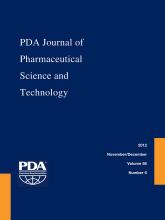Abstract
Leptospira licerasiae, a novel bacterial contaminant found in Genentech cell culture manufacturing operations, poses a challenge to current microbial control strategies in upstream cell culture processes, as this microorganism is fully capable of passing through 0.1 μm sterilizing-grade filtration and is not detectable by standard microbiological methods described in major pharmaceutical compendia for microbial screening and quantification required for release of raw materials, in-process intermediates, and finished products in biopharmaceutical production. The root cause investigation was greatly aided by the genetic identification of the contaminant and subsequent confirmation by cultural method and real-time polymerase chain reaction assay from the affected product batches. The purpose of this case study is to share knowledge on the novel contaminant, L. licerasiae, and potential routes of contamination in the cell culture manufacturing environment from a series of investigations involving root cause analysis, impact assessments, risk assessment, and global corrective and preventative action, as well as to provide guidance on the detection and prevention of Leptospira contamination with the intent to aid the industry to continually improve microbial control strategies for the benefit of patients.
LAY ABSTRACT: Leptospira licerasiae, a novel bacterial contaminant found in cell culture manufacturing operations, poses a challenge to current microbial control strategies in upstream cell culture processes because this microorganism is capable of passing through 0.1 μm sterilizing-grade membrane filters and is not detectable by standard microbiological methods used in biopharmaceutical production. The root cause investigation was greatly aided by the genetic identification of the contaminant and subsequent confirmation by cultural method and real-time polymerase chain reaction assay from the affected product batches. The purpose of this case study is to share knowledge on the novel contaminant, L. licerasiae, and potential routes of contamination in the cell culture manufacturing environment from a series of investigations to provide the industry with guidance on the detection and prevention of Leptospira contamination.
- Bioreactor contamination
- Corrective and preventative action
- Chinese Hamster Ovary cell culture
- Leptospira licerasiae
- Polymerase chain reaction
- Seed train bioreactor
- © PDA, Inc. 2012
PDA members receive access to all articles published in the current year and previous volume year. Institutional subscribers received access to all content. Log in below to receive access to this article if you are either of these.
If you are neither or you are a PDA member trying to access an article outside of your membership license, then you must purchase access to this article (below). If you do not have a username or password for JPST, you will be required to create an account prior to purchasing.
Full issue PDFs are for PDA members only.
Note to pda.org users
The PDA and PDA bookstore websites (www.pda.org and www.pda.org/bookstore) are separate websites from the PDA JPST website. When you first join PDA, your initial UserID and Password are sent to HighWirePress to create your PDA JPST account. Subsequent UserrID and Password changes required at the PDA websites will not pass on to PDA JPST and vice versa. If you forget your PDA JPST UserID and/or Password, you can request help to retrieve UserID and reset Password below.






